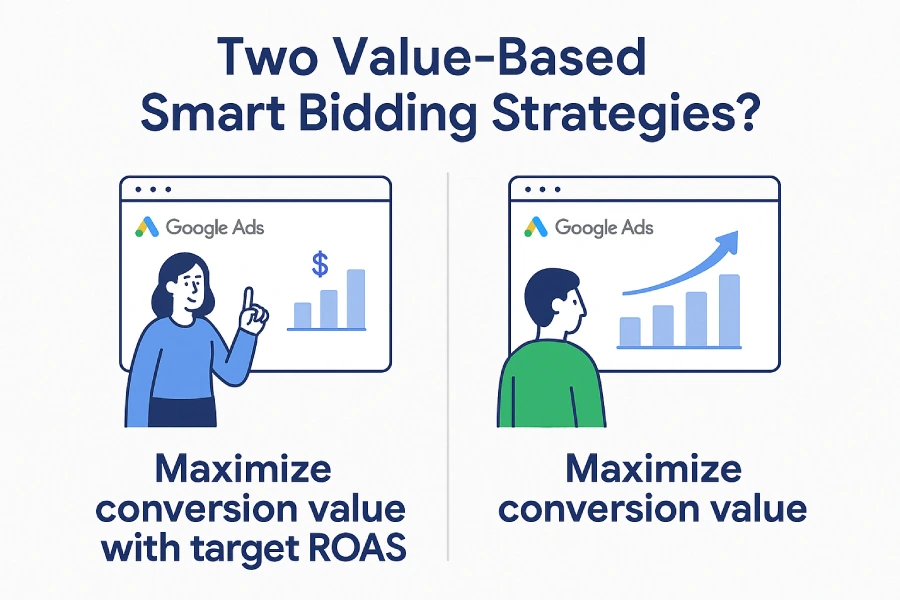When I was preparing for the Google Ads Search Certification exam (which I proudly passed with a 97% score!), one question stood out because it highlighted a huge mindset shift: you shouldn’t just count conversions—you should count value.
That’s where value-based Smart Bidding comes in. In this post, I’ll break down the correct answer to this question, explain what value-based bidding really means, why the wrong options don’t work, and how you can apply it to real campaigns. Let’s dive in!
Question
What are two types of value-based Smart Bidding strategies?
- Maximize conversion value with target ROAS
- Manual CPC
- Target impression share
- Maximize conversion value
Here are two correct answers:
✅ Maximize conversion value with target ROAS
✅ Maximize conversion value
Why These Two Are Correct
1. Maximize Conversion Value
This strategy tells Google to get the most conversion value (like sales revenue) possible with your budget.
- Google uses machine learning to prioritize high-value clicks.
- Best when you don’t want to set a specific ROAS (return on ad spend) target.
- Example: If you sell items from $10 to $500, Google will optimize for the higher-value sales.
2. Maximize Conversion Value with Target ROAS
This is similar, but now you set a goal like “I want $5 back for every $1 I spend.”
- Google tries to hit that goal while bidding.
- Great for ROI-focused campaigns.
- Example: If your target ROAS is 500%, you want $5 return for every $1 ad spend.
These are Smart Bidding strategies, meaning Google adjusts bids automatically based on real-time signals (device, location, time, etc.) to get the most valuable results.
Why the Other Options Are Wrong
❌ Manual CPC
- This is not Smart Bidding.
- You manually set bids and have full control.
- No automation or value tracking is involved.
❌ Target Impression Share
- This is Smart Bidding, but it’s designed for visibility, not value.
- It focuses on how often your ad appears, not what your conversions are worth.
- Used for brand awareness or keyword dominance.

Comparison Table: Bidding Strategies Overview
| Bidding Strategy | Smart Bidding | Value-Based | Goal |
|---|---|---|---|
| Maximize Conversion Value | ✅ Yes | ✅ Yes | Get the most value within budget |
| Max. Conv. Value w/ Target ROAS | ✅ Yes | ✅ Yes | Value with a return target |
| Manual CPC | ❌ No | ❌ No | Click control |
| Target Impression Share | ✅ Yes | ❌ No | Maximize visibility |
Real-Life Example:
Let’s say Tina owns an online boutique. She sells handbags ranging from $40 to $300. Previously, she ran a campaign using Maximize Conversions, and got 20 sales.
But when she checked, most of those were $40 bags. Her revenue wasn’t as high as she expected.
She switches to Maximize Conversion Value, and later to Target ROAS (400%). Google now prioritizes the higher-priced handbags. Even if she gets fewer sales, her total revenue jumps by 35%.
Value-based bidding shifted her strategy from quantity to profitability.
FAQs:
Q1: What’s the difference between value-based and volume-based bidding?
Value-based = aims for more revenue.
Volume-based = aims for more conversions.
Q2: Can I use these strategies with any campaign?
Only if you have conversion tracking with value set up. E-commerce stores are a great fit.
Q3: What is a good ROAS to target?
It depends on your profit margins. Start with 300% and adjust based on performance.
Q4: Are these strategies automated?
Yes! Google uses machine learning to adjust bids in real time based on thousands of signals.
Conclusion:
Value-based Smart Bidding is the future of profitable advertising. If you care about revenue, not just leads, use:
- ✅ Maximize conversion value for growth-focused campaigns
- ✅ Target ROAS when you want efficiency and return
Stop just chasing conversions. Start chasing value.
Now, if you are ready, you can take the Google Skillshop test for the Google Ads Display Exam. Want more real exam questions with easy answers like this? Follow along — I’ll be breaking down more Google Ads Display Measurement Certification Free examples in the next posts.

